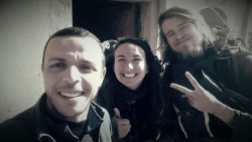Walking Through No-Man’s Land

The 3km stretch of land between Western Sahara and Mauritania is affectionately known as No-Man’s Land. It is a sprawling desert wasteland complete with burned out cars, stranded transport trucks, and makeshift camps. It is the last place you would want to live, and yet, people do.
Although it is called No-Man’s Land, this part of the world is actually controlled by the Sahrawi Arab Democratic Republic (SADR). It is one of the only part of Western Sahara that is controlled by the SADR. There is not much to rule over.
During the war over Western Sahara between Morocco, Mauritania, and the SADR, this area was littered with land mines which frequently exploded near the road. Today, these land mines have been cleared within 3km of the road, yet people still warn against walking the distance. We figured this was mostly because many people make a living driving people to and from the border with Mauritania and we assumed it was possible to walk, so we did. Although, it is worth noting that even though the land mines have been mostly cleared, straying very far off the path is a terrible idea as there are still active mines in the desert. We heard a story about a French couple who decided to go off-roading a few years ago and were killed by a stray mine.
No-Man’s Land is certainly one of the strangest places we have walked through. We heard that people get stuck in between the two countries as they are not allowed to enter Western Sahara (most are trying to get to Morocco) but they can’t re-enter Mauritania. However, when we spoke to people in No-Man’s Land it seemed as if getting back into Mauritania was not a problem but that people just chose to stay for reasons that remain unclear. I suppose the lure of one day entering Morocco is worth it for people? Or maybe the ability to live freely as their ancestors did is worth the hardships and the risk of maiming by landmine?
As soon as we left Morocco and set foot in No-Man’s Land we were swarmed with people. Some offering rides across, some trying to sell Mauritanian SIM cards at an elevated rate, some attempting to exchange our Dirham into Euros or Ouguiya. There were tents set up in between trucks and people were working as mechanics or taxi-drivers, somehow making a living like this. It seemed to be an impossible lifestyle seeing as how there are no stores in which to buy food or water. The native people are nomadic but with land mines scattering the landscape, it would be difficult to maintain that kind of existence.
The sun was blazing hot and there was no shelter for the passerby. People were kind to us, said hello but were a bit perplexed as to why we were walking. There are no official laws here but nonetheless, we were left to ourselves and never felt the slightest bit threatened. People passing by even offered to give us rides for free, but we preferred to continue to walk, knowing that this would almost certainly be the only time we would get a chance to do so.
In certain places, the road disappeared completely and trucks had to wind around the sand looking for the most optimal route to drive through without getting stuck. We tried to stay close to the trucks or at least follow in recent tracks in the sand. I knew there were no land mines in the area but couldn’t shake the nerves that maybe just one had been missed and I would make an unfortunate move and wind up as a front page story, “Dumb Tourists Forgoes Warnings, Walks Through Minefield, Loses Both Legs”.
Ultimately, we made it in one piece and were able to get some footage of crazy scenery that felt totally surreal. We finally came close enough to the Mauritanian side where another “village” had popped up. Again, it was more of the same only in this area there were perhaps more rusted, abandoned cars.
We wanted to find some people to interview about living there. We were so curious about how people could get stuck living in such a desolate place like this and how they manage to survive. One man was resting in the shade of a car and we approached asking if he wouldn’t mind talking with us. He agreed but insisted on not being on camera. It turned out he didn’t even live there but was just a taxi driver, bringing people back and forth.
This piqued our interests even more. Why were so many people just hanging out in this harsh landscape, working jobs they surely could do in a more sociable, scenic environment? We continued our quest to find out more and came across another man willing to talk to us who invited us to his camper for tea.
He lived in an old school camper van, which he had converted into a home complete with a mattress, two chairs, and a propane burner. Because of Gabe’s french, we were able to gather that he was a mechanic who was also flipping cars. Somehow. Out here. With basically nobody around. WHO WAS HE SELLING THEM TO?!
The camper van he had bought from a French guy a while back and although he could go back to Mauritania whenever he wanted to, he preferred living in his van. This whole thing had me so perplexed. Was Mauritania that bad that people preferred to live in a place where nature is almost hellbent on killing you? (For an answer to this question, check out our overview of Mauritania). Perhaps, to some, this lawless place was preferable to the strict, traditional and conservative way of life just south of the border. Are these Mauritania’s crust-punks?!
He made us tea, we exchanged some pleasantries, took some pictures and went on our way. I felt like I had more questions now than I had before, but the day was getting shorter and we still had to deal with the infamous Mauritanian border crossing.
 The-Nomaddicts
The-Nomaddicts 


















Pingback: «La Tierra de nadie», «No Man’s Land», «Kandahar» … | tiempodificil